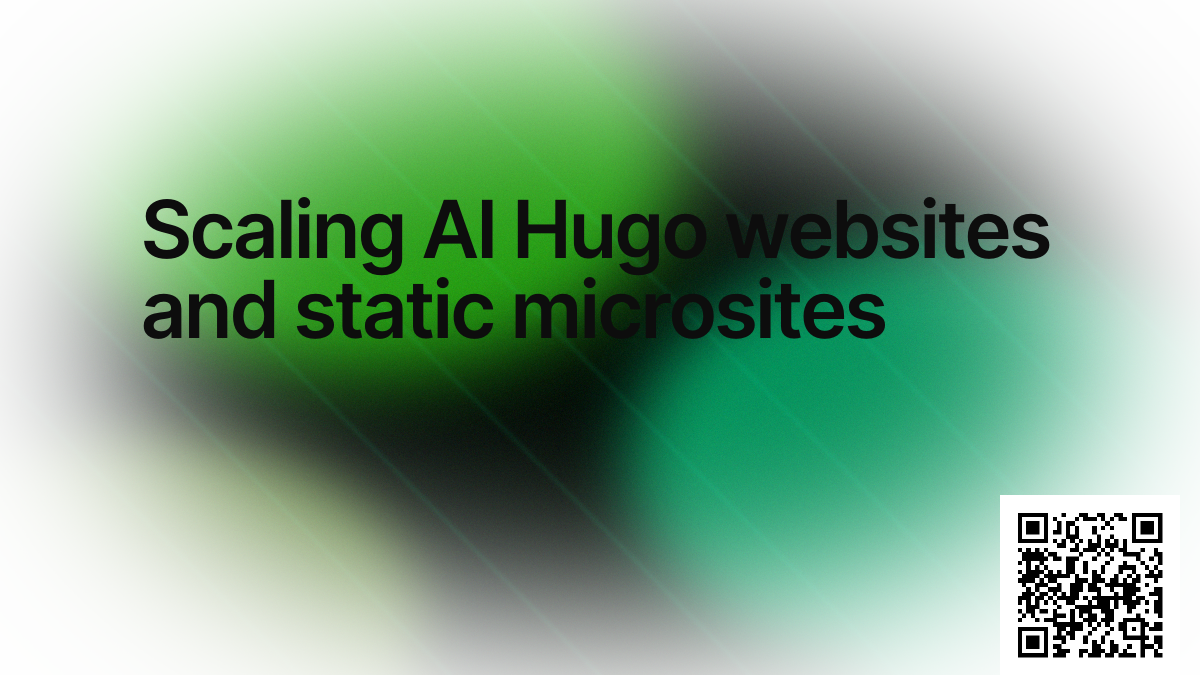Scaling AI Hugo websites and static microsites

Why static experiences are back
AI Hugo Websites and lightweight microsites load fast, ship clean markup, and avoid plugin sprawl. MyDomAI blends domain intelligence with an AI Website Builder so teams produce static assets that still adapt to buyer intent. Instead of waiting on sprints, operators compile entire campaigns with pre rendered templates, schema, and analytics baked in. That speed matters when a new domain trend emerges or when search engines reward fast, secure experiences.
Selecting the right domain portfolio
The domain intelligence engine evaluates registrar feeds, aftermarket data, and topical velocity to prioritize where static content will outperform dynamic stacks. Scorecards outline demand, CPC, and trust signals across AI Domain Names so leaders invest in the URLs that offer real upside. Portfolio views group domains into authority plays, mini sites, and campaign microsites, each with budget and staffing guidance. When the platform spots a surge in a related cluster, it suggests reserves, redirects, or content recycling to compound momentum. Treating domains as managed assets keeps governance, finance, and growth aligned on what success looks like.
Building AI Hugo websites with prompts
Web Design AI Prompts feed narrative, structure, and component usage into Hugo template generators that respect brand tokens. Website Builder AI Prompts then produce markdown, partials, and data files, each tagged with persona, funnel stage, and localization requirements. The AI Website Builder also exports pre rendered HTML, HTML code snippets, and AI enhanced banner ads ready for syndication. Writers review copy inside a collaborative workspace, while engineers preview compiled builds with analytics and consent script stubs already inserted. Because every object carries metadata, teams can redeploy modules into WordPress, Shopify, or headless CMS pipelines without duplication.
Handling AI static websites for every vertical
AI Static Websites are ideal for regulated industries, community hubs, and campaign landing pages where speed plus control matter. MyDomAI assembles compliance disclosures, tracking policies, and localization guidance directly into each build so legal teams sign off faster. Customers can spin up microsites for product launches, investor updates, or franchise recruiting without touching a CMS admin panel. The platform also renders AI content Iframe embeds and interactive calculators that slot into partner portals while keeping core markup minimal. Each asset inherits accessibility checks, lighthouse benchmarks, and performance budgets that keep static experiences running at top speed.
Shipping across global infrastructure
MyDomAI packages builds for cPanel, Apache, Nginx, Vercel, Netlify, Cloudflare Pages, and custom S3 workflows. Operators choose between git based deployment, zip archives, or API delivery, all with checksum verification and rollback points. When campaigns require personalization, the AI Website Builder can attach API calls, consent aware scripts, or lightweight edge functions without bloating the bundle. Static assets also include Open Graph images, favicons, and manifest files generated automatically from brand tokens. Teams log deployment history, host health checks, and uptime data inside the same console used for prompts and scoring.
SEO and Web Design LLM observability
SEO dashboards blend sitemap health, backlink growth, and keyword share for each static property. AI SEO GEO overlays show how AI Hugo websites appear in Google, Bing, Baidu, and privacy search engines. MyDomAI also tracks conversations across the leading twenty Web Design LLM interfaces, noting which prompts reference your domains. Suggested actions update metadata, regenerate sections, or spin up new microsites that target emerging questions and keyword gaps. The system even recommends link partnerships and syndication strategies based on conversion rates tied to each static asset.
Collaboration and governance
Role based access keeps engineers, marketers, legal, and finance aligned while protecting sensitive data. Approval workflows document who edited copy, changed prompts, or deployed new builds, creating a full audit trail. MyDomAI integrates with Slack, Teams, Jira, and Asana so updates reach stakeholders inside existing project systems. Reusable playbooks show how AI prompts to build entire websites map to policy requirements, asset libraries, and localization guardrails. Training modules capture best practices for prompting, testing, and deploying static experiences so new teams ramp quickly.
What is next for static operators
Product updates on the horizon include AI enhanced conversion optimization tuned for static funnels, gated content, and lead magnets. Upcoming releases add multilingual prompt packs, persona aware storytelling, and deeper integrations with analytics platforms like Looker and Tableau. MyDomAI is preparing API endpoints that allow product databases, pricing engines, or personalization services to populate static content on demand. Future work also includes AI Shopify and WordPress bridges, letting operators hand off campaigns between stacks without losing analytics history. With each iteration, AI Hugo websites and AI static websites gain deeper intelligence that keeps every domain in the portfolio compounding value.
More ways to accelerate
View all resources- AI WordPress websites that outrank competitors Why WordPress needs an AI upgrade AI Wordpress Websites promise faster launches, yet many teams still treat WordPress builds as linear … Read story
- AI Shopify websites that convert from day one Why Shopify merchants need AI speed AI Shopify Websites promise overnight store launches, yet most organizations still manage Shopify like a … Read story
